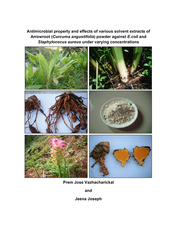| Departments | |
|---|---|
| Book Series (96) |
1378
|
| Nachhaltigkeit |
3
|
| Gesundheitswesen |
1
|
| Humanities |
2363
|
| Natural Sciences |
5406
|
| Mathematics | 229 |
| Informatics | 319 |
| Physics | 980 |
| Chemistry | 1363 |
| Geosciences | 131 |
| Human medicine | 243 |
| Stomatology | 10 |
| Veterinary medicine | 108 |
| Pharmacy | 147 |
| Biology | 835 |
| Biochemistry, molecular biology, gene technology | 121 |
| Biophysics | 25 |
| Domestic and nutritional science | 45 |
| Agricultural science | 1004 |
| Forest science | 201 |
| Horticultural science | 20 |
| Environmental research, ecology and landscape conservation | 148 |
| Engineering |
1791
|
| Common |
98
|
|
Leitlinien Unfallchirurgie
5. Auflage bestellen |
|
Advanced Search
Antimicrobial property and effects of various solvent extracts of Arrowroot (Curcuma angustifolia) powder against E.coli and Staphylococus aureus under varying concentrations (English shop)
Jeena Joseph (Author)Prem Jose Vazhacharickal (Author)
Preview
Extract, Datei (1.2 MB)
Table of Contents, Datei (560 KB)
Arrowroot (Curcuma angustifolia) is a herb belongs to Zingiberaceae family and widely cultivated in Tropics. Roots and tuber crops are the second popular cultivated species in Tropical countries after cereals. Tuber crops play a major role in fulfilling human nutritional requirements and provide a good source of variety of vitamins, fibre, K, Cu, Mn and Fe. Given lacking qualitative and quantitative data on Curcuma angustifolia in Kerala, the objectives of this research work were: (1) to identify and characterize morphological variations and (2) to determine antimicrobial properties against Staphlococus aureus and E.coli. Samples of Curcuma angustifolia were collected based on an elaborative literature survey as well as information’s collected from farmers. A total of 4 varieties were collected from different regions of the Kerala from January 2016 to February 2016. Morphological characterization of Curcuma angustifolia and specific characteristics of different varieties were studied. Branch leaf and stem were also collected and analysed for various parameters including stem length (SL), stem texture (ST), leaf color (LC), leaf shape (LS), leaf texture (LT), leaf length (LL), leaf breadth (LB), margins or lines, flower color (FC), flower shape (FS), rhizome shape (RS), rhizome color (RC), rhizome texture (RT), rhizome length (RL), rhizome breadth (RB), rhizome diameter (RD), and rhizome weight (RW). The experiment were conducted in a factorial manner, with three varieties (V1, V3 and V4); two concentrations (2 and 5%); and three solvents (methanol, chloroform and isoamyl alcohol). Antimicrobial assay was performed on Muller-Hinton agar plates with the Staphylococus aureus and E.coli. The triplicates plates were incubated at 36 ºC and the area of inhibition zones were measured on coming three consecutive days. Rhizome colour is different in the 4 varieties and shape also varied. In the chloroform extract, V3 variety shows more activity than the other two varieties. Concentration of the variety with 5% shows more zone of inhibition ie, 2.81 ± 0.5cm. The antimicrobial activity of Curcuma angustifolia against E.coli and Staphlococus aureus can be further explored for its full potential.
| ISBN-13 (eBook) | 9783736981096 |
| Language | English |
| Page Number | 45 |
| Edition | 1. |
| Publication Place | Göttingen |
| Publication Date | 2016-05-30 |
| General Categorization | Dissertation |
| Departments |
Agricultural science
|
| Keywords | Arrowroot, Tuber crops, Curcuma angustifolia |








